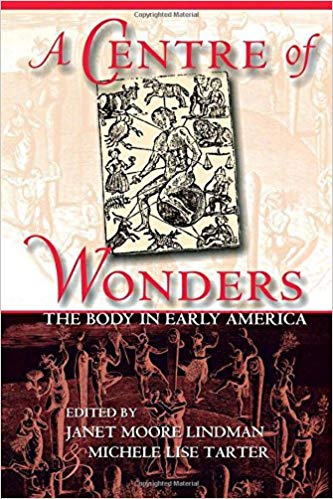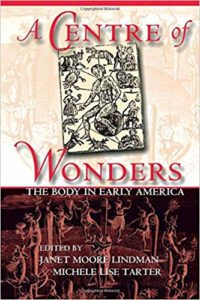Habeas Corpus?

The title of this collection of essays is taken from Benjamin Rush, prominent physician in post-Revolutionary Philadelphia. His words represent the long tendency among Europeans and Euro-Americans to regard the body as a microcosmic reflection of the entire universe or macrocosm. Each of the volume’s essays assumes that the human body was an important measure of cultural suppositions about the world and examines a different aspect of the body’s meaning in early America.
The book is divided into four thematic sections, each indicating an aspect of the body and its qualities. In the first section, on the body’s permeability, Robert Blair St. George examines parallel ideas of witchcraft’s damage to bodies and houses; Trudy Eden looks at apprehensions over consumption of new world foods in early Virginia; Martha L. Finch assesses the idea that civilized bodies could reduce the savage environment of Plymouth to civility; and Jacquelyn C. Miller analyzes Benjamin Rush’s political assumptions about balance and how they affected his medical practices. The book’s second section focuses on the body’s demarcations (often in relation to perceived threats to these boundaries). Kathleen M. Brown examines a case of infanticide in Massachusetts, noting Puritan obsessions with physical cleanliness and uncleanness; Jennifer M. Spear analyzes purity of blood concerns in Spanish Louisiana; and Susan M. Stabile examines Esther Burr’s interrelated and religiously inflected concerns with her body and her writing.
In the third section, on “bodies in performance,” Elizabeth Maddock Dillon and Michele Lise Tarter reinforce the religious significance of the body by examining, respectively, images of the religious sanctity of the female body and of the dangerously “quaking” bodies of the Society of Friends. Alice Nash looks at English descriptions of native Americans’ “antic” dance; Janet Moore Lindman returns to the theme of religion by looking at the body in Baptist belief and worship. The last section, “bodies in discourse,” includes Teresa A. Toulouse’s essay on Hannah Duston’s captivity among and murder of Indians as a statement of anxiety over English male power in New England; Nancy Shoemaker on ways in which Indians and Europeans had similar ideas about bodies but agreed that skin color made all the difference; Joanne Pope Melish on how cases of “white negroes” and of white captives in Algiers raised particular anxiety during the “first emancipation” in the early republic; and Todd D. Smith interrogates the puzzling absence of imagery of martial male bodies during the War of 1812.
The result is that often promised but rarely achieved object: an interdisciplinary project with contributions from scholars of history, art history, the history of science, and literature. And the range of topics considered is remarkable, demonstrating that concern over the body is not imposed by current scholars on the past but deeply embedded within the past.
So, who should read this book? I suspect that it will mostly appeal to scholars who work on early America and who are already interested in the history of the body. Two potential audiences–scholars of early modern Europe and historians of early America who are suspicious about “theory-led” inquiry into the past–will probably find less of interest.
The former group will be disappointed that there is so little that is identifiably American about the volume. Many of its themes, particularly the assessments of the religious and gender implications of the body, seem typical of all early modern societies, with their widespread concerns over witchcraft, gender roles, dangerous physical environments, and social disorder. We of course need to look at these topics in their American contexts, but they should be identified as typical of the early modern era rather than as characteristically American.
The essays that make the strongest original contributions to our understanding of early America focus on phenomena distinctive to the Western Hemisphere and its colonial history. These essays examine questions about race and cultural encounters, or about the political anxieties of the Revolution and early republic. These are, however, among the minority. More attention to clearly American discourses on the body–like the material presented by Spear, Nash, Shoemaker, Miller, Melish, and Smith–would have been welcome.
Further, many of the authors are selective about the secondary literature they use; the volume will look outdated to non-Americanists and predictable to historians who think that study of the body is part of the lunatic fringe. The volume is deeply influenced by Michel Foucault’s discourse on the body, especially his emphases on power and transgression. The scholars seem not to realize that study of the body has earlier and non-Foucauldian antecedents. (Ernst H. Kantorowicz’s The King’s Two Bodies: A Study in Medieval Political Theology [Princeton, 1957], for example, had tremendous impact among medievalists and scholars of political thought.) Discussion of this broader historiography would have better translated this subfield to outsiders.
Another example of this selectivity occurs in many of the authors’ dependence on Thomas Laqueur’s argument, from his Making Sex: Body and Gender from the Greeks to Freud (Cambridge, Mass., 1990), that until the late eighteenth century, Europeans accepted a “one sex” model of gendered physiology. None of these authors has assessed the substantial scholarly criticism of Laqueur, who overstated the Aristotelian idea that men and women had similar physiologies while understating Aristotle’s contention that the sexes had significantly different temperaments. Nor do the Laqueur-citers seem familiar with competing interpretations of premodern views on sex and gender, especially Joan Cadden’s Meanings of Sex Difference in the Middle Ages: Medicine, Science, and Culture (Cambridge, 1993).
It is perhaps telling that the authors of these essays are mostly junior and mostly female. None of them is above the level of associate professor; only two of the fifteen essays are by men. This probably indicates the kinds of scholars of early America who are interested in the (Foucauldian) history of the body and is in sharp contrast to another recent collection of essays on the body, David Hillman and Carla Mazzio, eds., The Body in Parts: Fantasies of Corporeality in Early Modern Europe (New York, 1997). In this volume, six of the fourteen essayists are full professors and seven are men; this indicates a more mature field whose more senior practitioners are as interested in the body as its junior ones. Further, that book’s organization, from head to foot, an essay for each important body part, shows the greater sophistication among scholars who focus on Europe and who are expected to come to terms with a larger, older, and more comprehensive literature. I hope this set of essays on the early American body will begin to lead us in this more sophisticated direction.
This article originally appeared in issue 2.3 (April, 2002).
Joyce E. Chaplin is professor of history at Harvard University. She is the author of An Anxious Pursuit: Agricultural Innovation and Modernity in the Lower South, 1730-1815 (Chapel Hill, 1993) and Subject Matter: Technology, the Body, and Science on the Anglo-American Frontier, 1500-1676 (Cambridge, Mass., 2001).
